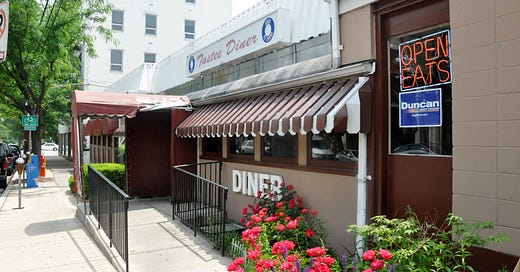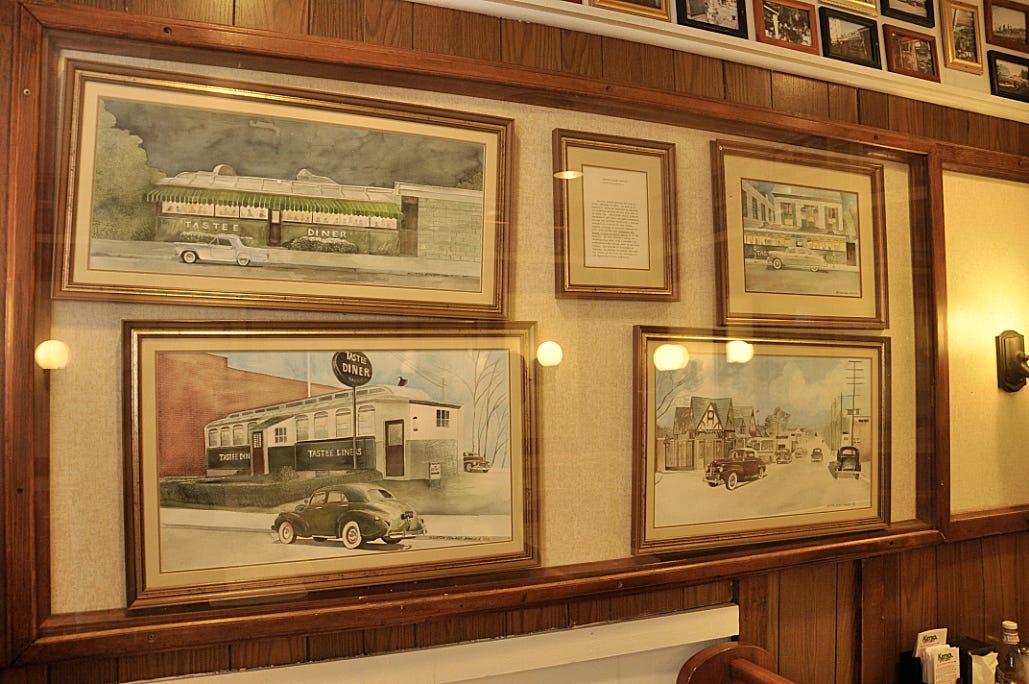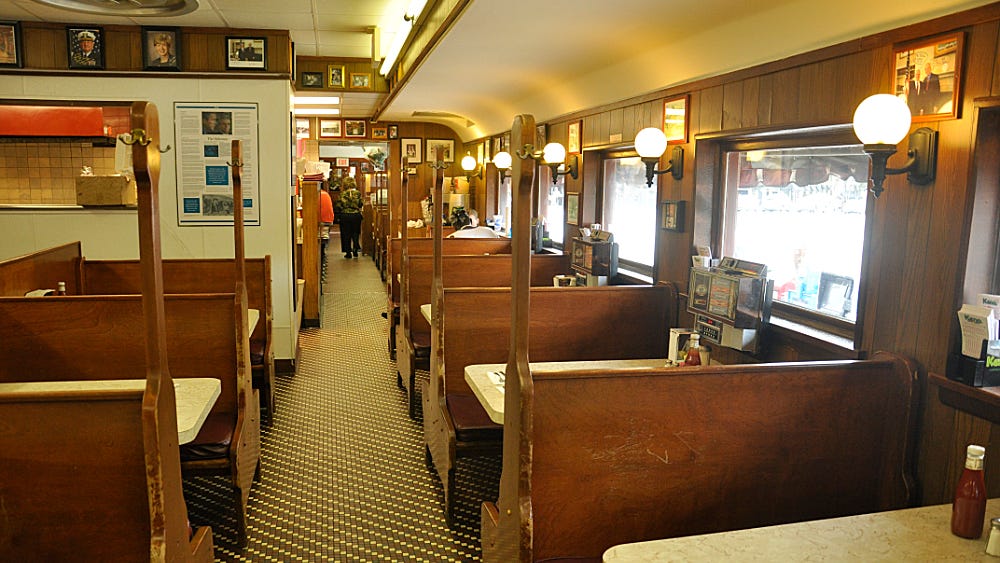Development Claims Silver Spring's Tastee Diner
Another Washington DC area classic diner gets a date with the bulldozer.
Thanks to a tip from a reader, I learned that the Tastee Diner in Silver Spring, Maryland has closed up for good and will likely face demolition. In 2014, I stopped by the Bethesda Tastee Diner to discuss the business with Gene Wilkes and Beth Cox, its owner and manager respectively, for my Diners of Maryland book that Stackpole Books would shelve.
In a chapter titled “Maryland: Land of the Diner Chains,” I included the three Tastees along with the Double T and the Nautilus Diner. To the best of my knowledge, the Bethesda location remains open for the foreseeable future. I include this story as a bonus feature for our paid subscribers.
Tastee Diner
The Tastee Diner chain stands as one of the holdouts from the diner’s golden age that saw not only some of the greatest designs produced by the industry, but a fairly common practice of expansion before the dominance of the franchise. The current owner of the chain, Gene Wilkes, did not start it, but he did rescue it.
Today, Gene has managers at each of the locations. At the Bethesda location, I had the pleasure of speaking not only to him, but to Beth Cox, a 36-year veteran working for Gene at this location. She started out as a cashier, eventually working her way up through the business, and today manages the round-the-clock operation with a well seasoned staff. In fact, besides Beth, on my morning visit, I met a grill man, counter guy, and two waitresses who combined experience in that diner totaled nearly 100 years. If you measure a diner's greatness by the longevity of its staff (and I do), then the Tastee ranks among the best ever.
The Tastee Diner chain was started by Eddie Warner in 1932 with his original unit in Silver Spring. He would move that unit to Rockville, replacing it with a new O'Mahony in 1946. The chain would eventually grow to three locations — Rockville, Silver Spring, and Bethesda, all O'Mahony products. Warner retired in 1968, leasing the Silver Spring location to George Traynor. For a time, the Tastee name belonged to Wilkes, his partner Leonard Milliken, and to Traynor. This continued until Milliken and Wilkes bought the Laurel location. By that time, the partners had added a Tastee in Fairfax, Virginia today known as the Tastee 29, but the partners split amicably in 1982 with Milliken getting the Fairfax location and Wilkes getting the Bethesda and Laurel locations.
In 1988, county officials prodded Wilkes to bring the Silver Spring location under his management as well. By that time, business had ground to a crawl, and county and city officials seeing the loss of the diner as a potential blow to their downtown arranged for incentives to compel Wilkes to buy in. The diner was listed on the county register of historical properties (though not yet the federal) and received considerable publicity as a result. With the three Maryland Tastees under his management, Wilkes trademarked the name.
The Laurel Tastee Diner came to the town in 1951 and replaced the original Laurel Diner. Today, the diner is one of only four Comac-built diners extant, the others in Albany, New York, Robbinsville, New Jersey, and Linden, New Jersey. Comac was a short-lived company in Irvington, New Jersey started by two former O'Mahony employees, and the Laurel diner was likely one of the last, if not the last off the shop floor.
The Silver Spring Tastee moved to its current site in 2002 after having to make way for new office construction. As part of the installation, Wilkes expanded the operation to include an expanded dining area. As noted by its historical filing, the diner "was a new model introduced by the O'Mahony company in 1946 that featured enlarged windows, curved glass corners, and taller trim above the windows. All of these featured de-emphasized the railroad style monitor roof that had been a dominant design element for more than twenty-five years."
Due to the still-ongoing shortage of materials in general and stainless steel in particular, the company clad the diner in broad sheets of canary yellow porcelain enamel and a red horizontal stripe. Today fewer than a handful of these examples still exist, with none that displays this style in such original condition.
The Bethesda store, the oldest in the chain, came to town in 1935 originally installed on Wisconsin Avenue, not too far from its current location. When it was moved in 1958, the lot across the street was still a cow pasture. Today, the diner sits at the near epicenter of one of the most bustling downtowns in all of Maryland. Fueled by the grown in government agencies in general and those related to health care in particular, Bethesda would look nearly unrecognizable to anyone returning after a twenty-year absence. In a perfect "be careful what you wish for" scenario, long-time residents bristle at the high-intensity gentrification that has swept over the town.
For those looking for a good diner might pass by the Tastee here thanks to the extensive exterior remodeling. A nearly catastrophic fire in 2002 brought further changes. Though mostly confined to the space between the ceiling and the roof, the repairs now completely obscure or removed the remainder of the diner's original monitor-style roof.

Sitting down to speak with Gene Wilkes and his manager Beth Cox is like sitting through a course in Diner People 101. Beth wears her long experience in this diner well. As one might expect of someone who has had a front row seat to a thirty-year stream of humanity coming through the doors of the diner, she's seen it all and them some. She gives the impression of someone will absolutely no tolerance for stupid behavior, but who would toss a total stranger the keys to her car if they needed a ride to the airport. She has, in fact, babysat for customers, and worries like a mother about those who don't show up for a while. Like it or not, she gets very invested in the well-being of her customers and their children.
The longer you watch Beth at work like this, the more you begin to appreciate the whole "third place" concept where we have home, work, and a third place that we regularly visit so often, we become part of the furniture.
Walking into the diner, I met Beth as she held a bag of grapes, pulling them one-by-one from the bag and eating them. "I'm trying to quit smoking," she said with an air of resignation, "but now I'm putting on weight."
Our rather wide-ranging conversation was frequently interrupted by greetings from customers coming and going that often involved inquiries about their children, friends, aunts and uncles. Two young men, one graduating from college that month and the other next year, got extra attention because their parents are long-time regulars at the diner.
There was also a former local radio personality who hadn't come in the diner in years, but who has since endured considerable hardships in that time, who received an extended greeting. The longer you watch Beth at work like this, the more you begin to appreciate the whole "third place" concept where we have home, work, and a third place that we regularly visit so often, we become part of the furniture.
As one of three diners, and as a patron of hundreds of diners, I wonder how anyone could reproduce this. The Laurel and Silver Spring locations, though homey in their own rights, don't quite feel like this, but as Beth points out, their neighborhoods have their own distinct character to them. Any good restaurant responds to its environment, but the Tastee seems to adapt well, though with the movement towards healthier eating and the neighborhood becoming more upscale, shouldn't the diner play down the emphasis on comfort food?
"For whatever reason, people come in here and expect certain things," Beth explains. "We certainly have the heavier meals, but we also have fresh seafood as well. We are trying to provide healthier options."
Nevertheless, when I ask, she does acknowledge that her customers are getting older, but she resists the notion that the diner will ever see a wholesale updating of its menu. She points out that "Gene is 70 years old. He's a good 70, though, and he looks great! But after Gene, I think that's going to be it for this place."
The menus at each restaurant reflect this as well. "No, they are not the same at each diner," Beth tells me. "This location has begin to concentrate a little more on healthier selections. For instance, gluten-free is big right now, so we're working those choices into our menu." Surrounded as it is by a full array of more contemporary styled restaurants and, of course, a Starbucks, I ask if we'll ever see an espresso machine in here.
"Never," she shoots back in utter certitude. "Gene is extremely loyal to his vendors. We've had Maxwell House coffee in here forever, and I don't think that's ever going to change."
Customers have enjoyed some welcome changes, however. In 1979, the new addition not only more than doubled the seating capacity, it expertly complemented the charm of the original structure. The untrained eye might think the new dining area dates back to Depression as well, but the lavish woodwork, the closely matched tile work, and the replica monitor-style ceiling replicate the style better than most owners would even think to try. This attention to detail speaks volumes of an operators dedication to the craft of hospitality and to the appreciation of the diner's value as a historic building.
That hard work does attract some interesting customers. As one would expect in a place so close to the seat of power, they get more than their fair share of politicians, but Beth told me she's also seen John Ratzenburger, of "Cheer's" fame, after "Cheers" left the airwaves.
"I couldn't tell if that was him or not," Beth said. "But as soon as he said something, I knew."
Also counted as a customer, Julia Louis-Dreyfus of Seinfield and more recently of Veep fame. She stopped in just before "Seinfeld" made it big.
Beth remarked, "She's a tiny woman. She can't be taller than five-feet."
However, when she revealed that Julia Child dropped by for breakfast back in the late 1980s, my jaw dropped.
"Isn't that like the pope dropping by your parish?" I asked.
"She ordered eggs and corned beef hash," Beth recounted matter-of-factly. "She was very nice." I happened to have the same thing that morning.
Gene Wilkes splits his time not only between his three diners, but he has interests in other enterprises as well. He provides further proof that success in this business comes from being there. How he got here in the first place takes us back to the time of the Nixon administration.
In 1970, Gene worked as a salesman for Wonderbread, and in that capacity, developed a good sense of his client's businesses. Given that diners sell a lot of bread, it provides a good barometer on the health of the enterprise. Salesmen often have a better how well a restaurant performs better than the owners. During that period, Bethesda was still a sleepy suburban bedroom community, but one that provided a good customer base for that Tastee location. Seeking a career change and an opportunity, Gene and Leonard Milliken bought the diner, which at that time had no addition and very little competition.
Investing in an old diner during their nadir took some nerve. In 1970, the diner-building industry had long hit its slippery slope, and old units such as this one had yet to be discovered as kitsch, much less a culinary trend. Gene saw a good restaurant in a growing community and worked to turn it around without changing its basic character. Indeed, he saw that as an asset, which helps to explain his choice of restaurant styles. After all, why not buy a storefront or build something new from scratch and call that a Tastee?
This does not come without a cost. Gene pointed out that owning old diners requires a great deal of attention to their upkeep. Twelve years after the fire, he plans to finish the repair work that initially applied a temporary fix to the ceiling using vinyl panels. When Gene arrived at the scene of the fire, he watched as the fireman drove their axes into the roof of the diner to get at the flames which had started from some overloaded wiring. The fire raged above the heads of the dinner crowd for some time before one of the customers looked up and noticed.
Beth remembers the day well. "I called Gene at his house and I said, 'Don't be mad, but the diner is on fire.' I never saw him get here so fast."
The panels up there now were a kind of band-aid fix, but Gene assures that the finished work might not be the original gumwood, but it will look much better than it does now.
Other operators often eschew the idea of dealing with vintage structures like this, but for Gene I sense a challenge in it for him. People know and appreciate the Tastees as landmarks, both of their communities and their own lives. In an area that has seen so much change, for some, the Tastee Diners provide the welcome respite from all that.
But as far as what will happen after he leaves the scene, Gene isn’t as certain as Beth. “I don’t know what will happen. The only reason I’m still here today is because I own the land underneath this diner.” If not, the real estate pressures would have forced him out long ago. Downtown Bethesda now looks like a few blocks of Manhattan.






